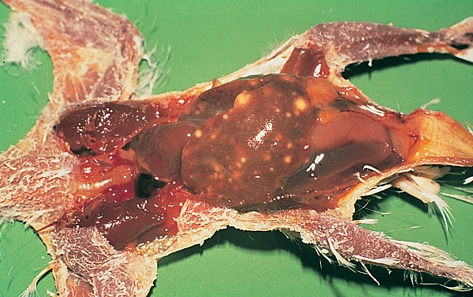Difference between revisions of "Avian Medicine Q&A 19"
(Created page with "<br style="clear:both;" /> {| align="left" width="100%" style="background-color:#04B4AE" |- | align="center" | 90px|Mansonlogo | align="left" | This ques...") |
|||
| (One intermediate revision by the same user not shown) | |||
| Line 3: | Line 3: | ||
|- | |- | ||
| align="center" | [[File:Manson_logo.gif|90px|Mansonlogo]] | | align="center" | [[File:Manson_logo.gif|90px|Mansonlogo]] | ||
| − | | align="left" | This question was provided by [[:Category:Manson|Manson Publishing]] as part of the [[OVAL Project]]. See more [[Category: Avian Medicine Q&A|Avian Medicine questions]] | + | | align="left" | This question was provided by [[:Category:Manson|Manson Publishing]] as part of the [[OVAL Project]]. See more [[:Category: Avian Medicine Q&A|Avian Medicine questions]] |
|} | |} | ||
<br><br><br> | <br><br><br> | ||
| Line 13: | Line 13: | ||
|q1= What is your most likely presumptive diagnosis? | |q1= What is your most likely presumptive diagnosis? | ||
|a1= Infection with ''Yersinia pseudotuberculosis'' or ''Salmonella typhimurium'' is regularly seen in canaries during the winter months in birds of all ages. The clinical signs are not specific: in addition to those mentioned above, an acute catarrhal pneumonia and a typhlitis may be present. | |a1= Infection with ''Yersinia pseudotuberculosis'' or ''Salmonella typhimurium'' is regularly seen in canaries during the winter months in birds of all ages. The clinical signs are not specific: in addition to those mentioned above, an acute catarrhal pneumonia and a typhlitis may be present. | ||
| − | |l1= | + | |l1=Salmonellosis - Birds |
|q2= How can you confirm this diagnosis? | |q2= How can you confirm this diagnosis? | ||
|a2= Many rod-shaped bacteria are seen in impression smears from all the organs. The diagnosis is confirmed after culturing the micro-organisms. | |a2= Many rod-shaped bacteria are seen in impression smears from all the organs. The diagnosis is confirmed after culturing the micro-organisms. | ||
| − | |l2= | + | |l2=Yersiniosis - Birds |
|q3= What should be your therapy? | |q3= What should be your therapy? | ||
|a3= The mostly commonly effective antibiotics are trimethoprim (with or without sulpha), amoxycillin or enrofloxacin via the drinking water or soft food. | |a3= The mostly commonly effective antibiotics are trimethoprim (with or without sulpha), amoxycillin or enrofloxacin via the drinking water or soft food. | ||
| Line 25: | Line 25: | ||
A connection has been suggested between contamination of food supplies by rodents and yersiniosis; although serotypes are often similar between rodent and avian Yersinia sp., no definite link has ever been proven. It is also likely that infection may occur through contact between infected feral birds and captive birds. In view of this contact, and access by rodents to birds or their food supplies, control of these factors is necessary. | A connection has been suggested between contamination of food supplies by rodents and yersiniosis; although serotypes are often similar between rodent and avian Yersinia sp., no definite link has ever been proven. It is also likely that infection may occur through contact between infected feral birds and captive birds. In view of this contact, and access by rodents to birds or their food supplies, control of these factors is necessary. | ||
| − | |l3= | + | |l3=Yersiniosis - Birds |
</FlashCard> | </FlashCard> | ||
| Line 32: | Line 32: | ||
desc none}} | desc none}} | ||
[[Category: Avian Medicine Q&A]] | [[Category: Avian Medicine Q&A]] | ||
| − | |||
Latest revision as of 15:20, 1 September 2011
| This question was provided by Manson Publishing as part of the OVAL Project. See more Avian Medicine questions |
You are confronted with a flock of canaries with ruffling of the feathers, debilitation and high mortality. At necropsy, a dark, swollen, congested liver and spleen with small, yellow, focal granulomas are found as shown.
| Question | Answer | Article | |
| What is your most likely presumptive diagnosis? | Infection with Yersinia pseudotuberculosis or Salmonella typhimurium is regularly seen in canaries during the winter months in birds of all ages. The clinical signs are not specific: in addition to those mentioned above, an acute catarrhal pneumonia and a typhlitis may be present.
|
Link to Article | |
| How can you confirm this diagnosis? | Many rod-shaped bacteria are seen in impression smears from all the organs. The diagnosis is confirmed after culturing the micro-organisms.
|
Link to Article | |
| What should be your therapy? | The mostly commonly effective antibiotics are trimethoprim (with or without sulpha), amoxycillin or enrofloxacin via the drinking water or soft food.
Once sensitivity test results are obtained, the antibiotic may need to be changed. Cleaning and disinfection are essential to prevent a relapse after therapy has been completed. A connection has been suggested between contamination of food supplies by rodents and yersiniosis; although serotypes are often similar between rodent and avian Yersinia sp., no definite link has ever been proven. It is also likely that infection may occur through contact between infected feral birds and captive birds. In view of this contact, and access by rodents to birds or their food supplies, control of these factors is necessary. |
Link to Article | |
